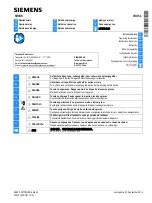
CVQ Relay
41-223N
3
2.2
NEGATIVE SEQUENCE FILTER
The voltage filter consists of an auto-transformer,
reactor, and resistors connected as shown in the
internal schematic Figure 1 (page 2).
2.3
VOLTAGE UNIT (CV)
The voltage unit operates on the induction-disc prin-
cipal. A main tapped coil located on the center leg of
an “E” type laminated structure produces a flux which
divides and returns through the right leg (front view)
to lag the main pole flux. The out-of-phase fluxes
thus produced in the air gap causes a contact closing
torque.
2.4
INDICATING CONTACTOR SWITCH (ICS)
The indicating contactor switch is a small dc oper-
ated clapper type device. A magnetic armature to
which leaf-spring mounted contacts are attached is
attracted to the magnetic core upon energization of
the switch. When the switch closes, the moving con-
tacts bridge two stationary contacts, completing the
trip circuit. Also during this operation two fingers on
the armature deflect a spring located on the front of
the switch, which allows the operation indicator tar-
get to drop. The target is reset from the outside of the
case by a push-rod located at the bottom of the case.
The front spring, in addition to holding the target, pro-
vides restraint for the armature and thus controls the
pickup value of the switch.
2.5
FULL WAVE BRIDGE
The full wave bridge consists of four diodes con-
nected to the output of the negative sequence filter.
The output is rectified, filtered and fed to the polar
unit through an adjustable resistor, which is used to
set the sensitivity of the relay.
2.6
AUXILIARY TIME DELAY UNIT (T) – WHEN
USED
This slugged telephone type unit in series with a
resistor, provides a 6 to 7 cycle delay on pick-up. The
resistor is to be shorted for 48 Vdc operation as
shown in the Internal Schematic of Figure 2 (page 2).
3.0 CHARACTERISTICS
Polar Unit
— The sensitivity of the negative
sequence portion of the relay is adjustable between 5
and 10 percent of the rated line to neutral voltage.
Voltage Unit
— Tap value voltage is the value at
which the overvoltage front contact (left-hand, front
view) closes. The undervoltage back contact (right-
hand, front view) will close within 5% of this value.
When used as an overvoltage relay, the moving con-
tact is initially at rest against the back contact for val-
ues of voltage less than tap value. With application of
overvoltage greater than tap value, the moving con-
tact moves to close the front contact in a time as
shown by the right-hand curves of Figure 3 (page 8).
When energized and used as an undervoltage relay,
the moving contact is initially at rest against the front
contact for values of voltage greater than tap value.
With the reduction of voltage to less than tap value,
the moving contact moves to close the back contact in
a time as shown by the left-hand curves of Figure 3.
3.1
REDUCED FREQUENCY OPERATION
Operation of the E2 unit will occur at approximately
54 Hz with rated positive sequence voltage applied
when set for 5% negative-sequence pickup at 60 Hz.
With a 10% setting, operation occurs at approxi-
mately 48 Hz.
3.2
TRIP CIRCUIT
The main contacts will safely close 30 amperes at
250 volts dc and the seal-in contacts of the indicating
contactor switch will safely carry this current long
enough to trip a circuit breaker.
The indicating contactor switch has two taps that pro-
vide a pickup setting of 0.2 or 2 amperes. To change
taps requires connecting the lead located in front of
the tap block to the desired setting by means of a
screw connection.
3.3
TRIP CIRCUIT CONSTANTS
Indicating
contactor
switch
–
0.2 amp tap 6.5
ohms dc resistance.
2.0 amp tap 0.15
ohms dc resistance.
4.0 ENERGY REQUIREMENTS
The burden of the undervoltage CV unit at rated volt-
age are as follows:


































